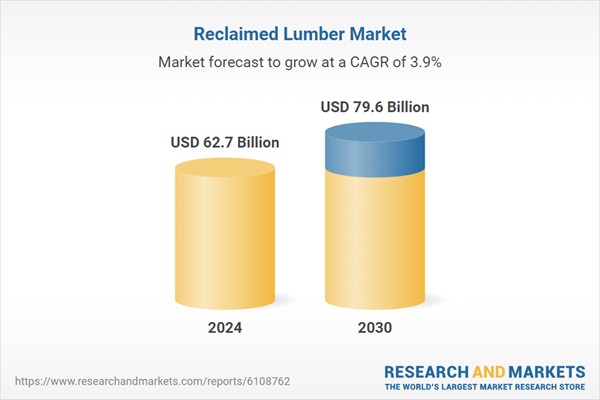Speak directly to the analyst to clarify any post sales queries you may have.
10% Free customizationThis report comes with 10% free customization, enabling you to add data that meets your specific business needs.
Key Market Drivers
Rising Demand for Sustainable and Eco-Friendly Construction Materials
The growing global emphasis on sustainability in the construction sector is a major factor driving demand for reclaimed lumber. This wood, sourced from deconstructed buildings and infrastructure, offers an eco-conscious option by reducing reliance on new timber and lowering environmental impact. As climate change and resource conservation concerns rise, industry professionals and consumers are increasingly turning to reclaimed materials. Green building certification programs like LEED and BREEAM encourage the adoption of recycled materials, significantly boosting reclaimed wood use across projects. Additionally, government incentives and updated building codes that favor sustainable practices are amplifying this shift in material preferences.Key Market Challenges
Inconsistent Quality and Supply Chain Limitations
The reclaimed lumber market faces notable challenges, particularly due to the inconsistent quality and limited availability of salvaged wood. Materials reclaimed from aging structures can vary significantly in terms of durability, size, moisture levels, and overall condition, complicating their use in standardized construction. The presence of embedded materials or past chemical treatments often requires extensive cleaning and processing, increasing labor and costs. Moreover, reclaimed lumber must meet modern structural and safety codes, which not all salvaged wood can achieve. Supply limitations further compound these issues, as the availability of reusable wood depends on regional demolition activity and aging infrastructure, leading to price volatility and sourcing difficulties.Key Market Trends
Integration of Reclaimed Lumber in Modern and Luxury Architecture
An emerging trend in the global reclaimed lumber market is its growing presence in contemporary and luxury architecture. Reclaimed wood is increasingly featured in high-end residential, commercial, and hospitality spaces, blending its rustic charm with modern design elements. This fusion of old and new - popularly termed “modern rustic” or “industrial chic” - uses reclaimed lumber alongside materials like glass and metal to create visually striking and sustainable environments. Its use has expanded beyond traditional flooring to include wall treatments, exposed beams, custom furniture, and decorative fixtures. The trend reflects a broader architectural movement that values authenticity, eco-consciousness, and aesthetic uniqueness.Key Market Players
- Vintage Timberworks Inc.
- Elmwood Reclaimed Timber, Inc.
- TerraMai Reclaimed Woods
- The Hudson Company
- Longleaf Lumber Inc.
- Barn Wood Industries
- Olde Wood Ltd.
- Trestlewood
Report Scope:
In this report, the Global Reclaimed Lumber Market has been segmented into the following categories, in addition to the industry trends which have also been detailed below:Reclaimed Lumber Market, By End-use:
- Residential
- Commercial
- Industrial
Reclaimed Lumber Market, By Application:
- Flooring
- Paneling
- Beams & Boards
- Furniture
- Others
Reclaimed Lumber Market, By Region:
- North America
- United States
- Canada
- Mexico
- Europe
- Germany
- France
- United Kingdom
- Italy
- Spain
- Asia Pacific
- China
- India
- Japan
- South Korea
- Australia
- South America
- Brazil
- Colombia
- Argentina
- Middle East & Africa
- Saudi Arabia
- UAE
- South Africa
Competitive Landscape
Company Profiles: Detailed analysis of the major companies present in the Global Reclaimed Lumber Market.Available Customizations:
With the given market data, the publisher offers customizations according to a company's specific needs. The following customization options are available for the report.Company Information
- Detailed analysis and profiling of additional market players (up to five).
This product will be delivered within 1-3 business days.
Table of Contents
Companies Mentioned
- Vintage Timberworks Inc.
- Elmwood Reclaimed Timber, Inc.
- TerraMai Reclaimed Woods
- The Hudson Company
- Longleaf Lumber Inc.
- Barn Wood Industries
- Olde Wood Ltd.
- Trestlewood
Table Information
| Report Attribute | Details |
|---|---|
| No. of Pages | 188 |
| Published | July 2025 |
| Forecast Period | 2024 - 2030 |
| Estimated Market Value ( USD | $ 62.7 Billion |
| Forecasted Market Value ( USD | $ 79.6 Billion |
| Compound Annual Growth Rate | 3.9% |
| Regions Covered | Global |
| No. of Companies Mentioned | 8 |









